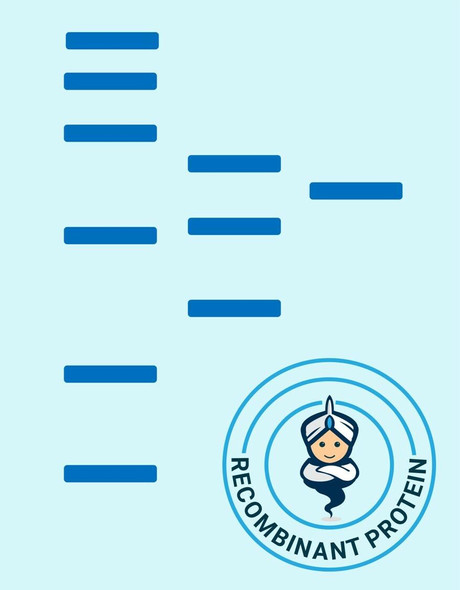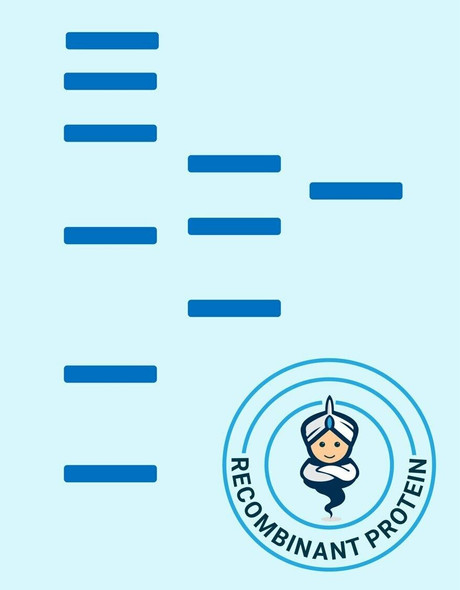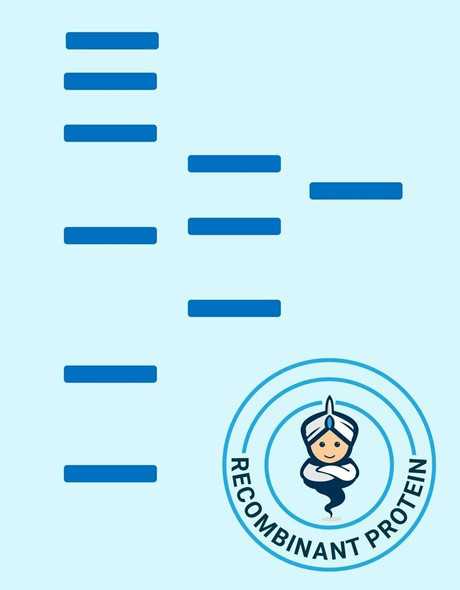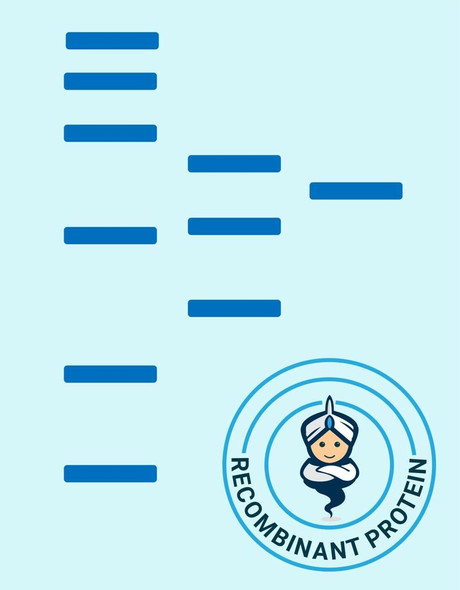Human Eotaxin Recombinant Protein (RPPB1122)
- SKU:
- RPPB1122
- Product type:
- Recombinant Protein
- Size:
- 20ug
- Species:
- Human
- Target:
- Eotaxin
- Synonyms:
- Small inducible cytokine A11
- CCL11
- Eosinophil chemotactic protein
- chemokine (C-C motif) ligand 11
- Source:
- Escherichia Coli
- Uniprot:
- P51671
Description
| Product Name: | Human Eotaxin Recombinant Protein |
| Product Code: | RPPB1122 |
| Size: | 20µg |
| Species: | Human |
| Target: | Eotaxin |
| Synonyms: | Small inducible cytokine A11, CCL11, Eosinophil chemotactic protein, chemokine (C-C motif) ligand 11, SCYA11, MGC22554. |
| Source: | Escherichia Coli |
| Physical Appearance: | Sterile Filtered White lyophilized (freeze-dried) powder. |
| Formulation: | Lyophilized from a 0.2µm filtered concentrated (1.0mg/ml) solution in 20mM PB, pH 7.4, 150mM NaCl. |
| Solubility: | It is recommended to reconstitute the lyophilized Eotaxin Human Recombinant in sterile 18M?-cm H2O not less than 100µg/ml, which can then be further diluted to other aqueous solutions. |
| Stability: | Lyophilized Eotaxin although stable at room temperature for 3 weeks, should be stored desiccated below -18°C. Upon reconstitution CCL11 should be stored at 4°C between 2-7 days and for future use below -18°C.For long term storage it is recommended to add a carrier protein (0.1% HSA or BSA).Please prevent freeze-thaw cycles. |
| Purity: | Greater than 97.0% as determined by:(a) Analysis by RP-HPLC.(b) Analysis by SDS-PAGE. |
| Amino Acid Sequence: | GPASVPTTCC FNLANRKIPL QRLESYRRIT SGKCPQKAVI FKTKLAKDICADPKKKWVQDSMKYLDQKSP TPKP |
| Biological Activity: | The activity is determined by the chemoattract of human PBE (peripheral blood eosinophils) at a concentration between 0.1-10 ng/ml corresponding to a Specific Activity of 100,000-10,000,000IU/mg. |
Chemokine (C-C motif) ligand 11 (CCL11) is a small cytokine belonging to the CC chemokine family that is also known as eotaxin. CCL11 selectively recruits eosinophils by inducing their chemotaxis, and therefore, is implicated in allergic responses. The effects of CCL11 are mediated by its binding to a G-protein-linked receptor known as a chemokine receptor. Chemokine receptors for which CCL11 is a ligand include CCR2, CCR3 and CCR5. The gene for human CCL11 (scya11) is encoded on three exons and is located on chromosome 17.
Eotaxin Human Recombinant produced in E.Coli is a single, non-glycosylated polypeptide chain containing 74 amino acids and having a molecular mass of 8345.9 Dalton. The CCL11 is purified by proprietary chromatographic techniques.
| UniProt Protein Function: | CCL11: In response to the presence of allergens, this protein directly promotes the accumulation of eosinophils, a prominent feature of allergic inflammatory reactions. Binds to CCR3. Belongs to the intercrine beta (chemokine CC) family. |
| UniProt Protein Details: | Protein type:Motility/polarity/chemotaxis; Secreted, signal peptide; Secreted Chromosomal Location of Human Ortholog: 17q12 Cellular Component: extracellular region; extracellular space; intracellular Molecular Function:CCR chemokine receptor binding; chemokine activity; protein binding Biological Process: actin filament organization; cell adhesion; cellular calcium ion homeostasis; chemotaxis; chronic inflammatory response; cytoskeleton organization and biogenesis; eosinophil chemotaxis; G-protein coupled receptor protein signaling pathway; inflammatory response; lymphocyte chemotaxis; mast cell chemotaxis; monocyte chemotaxis; neutrophil chemotaxis; positive regulation of actin filament polymerization; positive regulation of angiogenesis; positive regulation of cell migration; positive regulation of endothelial cell proliferation; positive regulation of GTPase activity; positive regulation of inflammatory response; protein amino acid phosphorylation; regulation of cell shape; response to radiation; response to virus; signal transduction Disease: Asthma, Susceptibility To; Human Immunodeficiency Virus Type 1, Susceptibility To |
| NCBI Summary: | This antimicrobial gene is one of several chemokine genes clustered on the q-arm of chromosome 17. Chemokines form a superfamily of secreted proteins involved in immunoregulatory and inflammatory processes. The superfamily is divided into four subfamilies based on the arrangement of the N-terminal cysteine residues of the mature peptide. This chemokine, a member of the CC subfamily, displays chemotactic activity for eosinophils, but not mononuclear cells or neutrophils. This eosinophil-specific chemokine is thought to be involved in eosinophilic inflammatory diseases such as atopic dermatitis, allergic rhinitis, asthma and parasitic infections. [provided by RefSeq, Sep 2014] |
| UniProt Code: | P51671 |
| NCBI GenInfo Identifier: | 1706661 |
| NCBI Gene ID: | 6356 |
| NCBI Accession: | P51671.1 |
| UniProt Secondary Accession: | P51671,P50877, Q92490, Q92491, |
| UniProt Related Accession: | P51671 |
| Molecular Weight: | 10,732 Da |
| NCBI Full Name: | Eotaxin |
| NCBI Synonym Full Names: | C-C motif chemokine ligand 11 |
| NCBI Official Symbol: | CCL11 |
| NCBI Official Synonym Symbols: | SCYA11 |
| NCBI Protein Information: | eotaxin |
| UniProt Protein Name: | Eotaxin |
| UniProt Synonym Protein Names: | C-C motif chemokine 11; Eosinophil chemotactic protein; Small-inducible cytokine A11 |
| Protein Family: | Eotaxin |
| UniProt Gene Name: | CCL11 |
| UniProt Entry Name: | CCL11_HUMAN |










